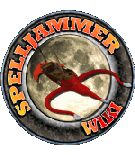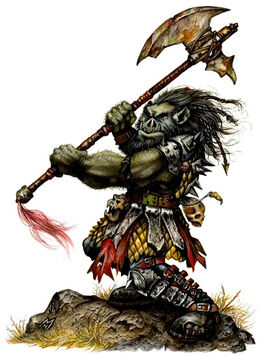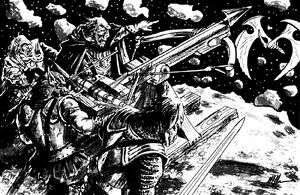Orcs are a minor[1] spacefaring race in the Spelljammer campaign setting, and are closely associated with other goblinoid races, including hobgoblins, ogres, goblins, bugbears, gnolls and scro.[2][3][4]
"Never trust an orc... even a dead one."
- Elvish aphorism.[5]
Overview[]
At one time the orcs and the other goblinoid races had a major presence in wildspace, fighting amongst themselves and against the other races in space, especially the elves. Although they were powerful, the goblinoid fleets were divided among a huge number of local chiefs, leaders and kings, and were unable to coordinate anything more than localised raids. However, considering their numbers, these raids completely depopulated whole regions of space, wiping out elven installations, human cities and dwarven citadels.
Most local kingdoms and organizations fought off these assaults as best they could, but the Elven Imperial Navy adopted their own solution: a full-fledged war against the goblinoid fleets in space. Beginning with the Battle of Kule in Greyspace, and continuing for the next decade, fully half of the various goblinoid fleets were destroyed, with the remaining forces scattered and later hunted down.
The power of the goblinoid fleets were crushed, but individual bands remain a factor in space. Those orcs that survived have gone on to operate in secret if they can, in the open if they must, but always to the benefit of their own kind.[2] Carefully hidden from the eyes of the Elven Fleet, orcish communities throughout wildspace have begun to rebuild their numbers in preparation for the coming time of retribution.[6] With the advent of the Second Unhuman War, many feel that the time has finally come.
Description[]
Orcs are aggressive humanoids who vary widely in appearance, as they frequently crossbreed with other species. In general, they resemble primitive humanoids with grey-green skin covered with coarse hair. Orcs have a slightly stooped posture, a low jutting forehead, and a snout instead of a nose. They have well-developed canine teeth for eating meat and short pointed ears that resemble those of a wolf. Orcish snouts and ears have a slight pinkish tinge. Their eyes resemble those of a human, with a reddish tint that sometimes glows red when they reflect dim light sources in near darkness. This is actually part of their optical system which allows them to see in the dark up to 60 feet.
Male orcs are about 5 1/2 to 6 feet tall, while females are typically 6 inches shorter than males. Orcs prefer to wear colors that most humans consider unpleasant: blood red, rust red, mustard yellow, yellow green, moss green, greenish purple, and blackish brown. They rarely maintain their equipment, which will often be dirty and a bit rusty.
Orcs speak Orcish, a language seemingly derived from older human and elven languages, which varies in dialect from tribe to tribe. Orcs have also learned to speak the languages of the surrounding communities but are usually not that comfortable with them. Some orcs also have a limited faculty with goblin, hobgoblin, and ogre dialects.[4]
Behavior[]
"Never forgive, never forget."
- Orcish aphorism.[7]
For orcs, unmitigated aggression is their natural state of mind. They believe that all other races are inferior to them, and live by the tenet that "might makes right". To them, subjugating and enslaving the weak is all part of the natural order. Orcs will cooperate with others, but are undependable: as slaves, they will rebel against all but the most powerful masters; as allies they are quick to take offense and break agreements. Orcs believe that battle is the greatest challenge in life, but some leaders are pragmatic enough to recognize the value of peace, which they exact at a high price. If great patience and care is used, orc tribes can be effective trading partners and military allies.
Orcs value territory above all else, and as a result are constantly at war with the surrounding communities, including humans, elves, dwarves, goblins, and other orc tribes. They take great pride in combat experience, prowess in battle, wealth, and number of offspring. Orc society is male dominated; women are fit only to bear children and nurse them. Orcs have a reputation for cruelty that is deserved, but humans are just as capable of evil. Though they are carnivorous, orcs prefer game meats or livestock to intelligent races.[4]
Combat[]
Orcs are constantly at war and use a variety of weapons, including axes, swords, spears, halberds, glaives and pikes, as well as bows and crossbows. They typically wear studded leather armor and may carry a shield. If a warchief, or subchief, is present there is a chance that a warband will be accompanied by a standard, improving the morale and self-confidence of all orc warriors within 60 yards.
Orcs hate direct sunlight, which negatively affects their ability to fight. Orcs employ sniping and ambush tactics and are not known for obeying the “rules of war” unless it is in their best interest; for example, they will shoot at those who attempt to parlay with them under a white flag unless the orc leader feels it is advantageous to hear what the enemy has to say. They abuse human rules of engagement and chivalry to their best advantage. They have a historic enmity against elves and dwarves and many tribes will attack them on sight.
Because orcs are so bloodthirsty and cruel, it is often believed that they are ineffective tacticians and would rather be vicious than victorious. Like most stereotypes, this is highly misleading. While true for some, most orc tribes have waged war for decades and have developed frighteningly effective battle tactics.[4]
Society[]
Orcs are a species of aggressive carnivores that band together in tribes and survive by hunting and raiding. Orcs believe that in order to survive they must expand their territory, and are constantly at war with their many enemies, including humans, elves, dwarves, goblins, and other orc tribes. Tribes typically have fearsome names such as Vile Rune, Bloody Head, Broken Bone, Evil Eye, and Dripping Blade. Orcs are skilled miners and excellent weaponsmiths.[4]
When the tide of war turned against them during the first Unhuman War, many orc's turned to their groundling cousins for sanctuary, and while the odd orc or half-orc may take refuge in a human city (or more likely below), there is no organized orc presence in wildspace apart from the odd "orcish nation" with three derelict and poorly maintained tradesmen raiders. However, rumors persist of some great "orcish horde" gathering beyond the Known Spheres, in some distant and particularly backward sphere. What few realise is that the threat may be closer to home. Several worlds, such as Borka in Greyspace[8], Armistice in Winterspace[9] and Plata,[10] have burgeoning populations of goblinoids who are the direct descendants of those survivors, and are just itching for the chance to get revenge on the Elven Imperial Fleet.[2] Other worlds with notable populations of orcs include Falx[11] and Chandos in Realmspace.[12]
Religion[]
Orcish religion is extremely xenophobic towards other species and encourages violence and warfare, driven by the need to acquire ever more territory. Orc shamans are noteworthy for their naked ambition, and many tribes have suffered because of political infighting between the warriors and priests.[4] Orcish tribes worship various deities (some who may have different names among the various tribes); however, the typical orcish pantheon is usually ruled with an iron fist by Gruumsh One-Eye, and typically includes the deities Bahgtru, Ilneval, Luthic, Shargaas and Yurtrus.[13]
Scro[]
The Scro are a highly militaristic and violent orcish race that has only recently made an appearance in the Known Spheres. The scro trace their ancestry back to the orc tribes that fought and lost the first Unhuman War. Led by a visionary warchief named Dukagsh, who gathered together as many ship crews and troops as he could, a small fleet of surviving orcish vessels made their way to a remote but habitable planet and settled down.
Recognising that the orcs had lost the Unhuman War because of their one-dimensional ideas, outmoded tactics and reliance on brutality, Dukagsh realized that the orcs needed to become more organized, and that each soldier must be made to realize their full potential. Naming himself the first Almighty Leader, Dukagsh whipped his people into shape in the ensuing years, making sure they learned everything they could about warfare, survival, and even culture. To make sure no one forgot who was to blame for their misfortune, each orc had to learn fluent elvish. Before Dukagsh died, he declared that his people were on the path to success. The old ways were dead, he claimed, and a new race was born, a race that was more than any orc could ever be. He named them the scro.[14]
Ice orc[]
The orcs of Armistice, dubbed "ice orcs" by the scro,[15] are the descendants of the Combined Goblin Fleet that was banished to this cold, brutal world at the end of the first Unhuman War. After centuries of near constant warfare, the Armistice orcs are even more brutal and warlike than their kin on other worlds (if that's even possible).
After many generations under the crushing gravity of Armistice, they have evolved and adapted to the brutal conditions: in appearance they are much shorter and stockier than other orcs, looking like some kind of unholy cross between an orc and a dwarf. Layers of corded muscle under a grey hide thicker than the toughest leather speaks to their incredible strength.[16] If the orcs of Armistice ever reached another planet, they would prove to be significantly stronger than others of their kind.[9]
Orc hybrids[]
Orcs can crossbreed with virtually any humanoid species except for elves. These mixed breeds tend to favor their orcish parent, though a small number can pass for ugly humans. Orc-goblins, orc-hobgoblins, and orc-humans are the most common, however, they have difficulty finding a place in either of their parent societies, as neither culture trusts them.[4]
Half-orc[]
Half-orcs are the offspring of human and orcish parents. Similar in height to half-elves, half-orcs usually resemble their human parent enough to pass for an ugly human in public. Their skin ranges in color from peach to olive to deep tan, and their hair can be blond, red, brown, black, gray, and shades in between.
Half-orcs are distrusted by both human and orc communities because they remind each of the other's racial stock. Half-orcs advance in orc society by flaunting their superior ability and in human culture by associating with people who don't care about appearance. Most tend toward neutrality with slightly lawful and evil tendencies, but lawful good half-orcs are not unknown. Some half-orcs have split from both cultures to form their own societies in remote areas. These half-orcs worship their own gods and are extremely suspicious of strangers.[4]
Orog[]
Orogs are a race of elite orcs and are thought to be the offspring of a male orc and a female ogre.[17] They range in height between 6 and 6 1/2-feet tall, and are highly disciplined warriors. They have their own standards and banners which they display prominently, and often serve in the vanguard of large orcish armies. Groups of orogs have also been known to hire themselves out as mercenaries.
One in ten orcish tribes have orog members, who make up about 10% of the total male population (thus a community with 3,000 male orcs has a chance of having 300 additional orogs.) Orogs use a variety of weapons and typically wear plate mail armor.[18]
Ogrillon[]
Ogrillons are the offspring of a male ogre and a female orc, and are thankfully sterile. They are more brutish and violent than their half-ogre kin and normally can only speak the ogre tongue, and perhaps a handful of words in common. An ogrillon is the size of an orc, and closely resembles one. However, about one in every ten is born with features and coloration similar to that of an ogre: purple eyes with white pupils, black teeth, yellowish skin with dull, dark green hair. The skin of an ogrillon is covered with small horn-like plates, giving it a form of natural armor and allowing it to fight without weapons. An ogrillon typically disdains armor and most other material items, retaining only a handful of gold pieces as treasured belongings.
Ogrillons love mayhem and willingly plunge into combat with both fists, and will often be seen chuckling merrily to themselves during a good fight. Out of combat though, an ogrillon is restless and troubled. Because of their single-mindedness, ogrillons are often recruited by orcs when they need good fighters against some enemy. Ogrillons are happy to join and fight, sometimes for the love of combat and destruction, but often for more lucky gold pieces.[19]
Notable Orcs[]
- Barabas was a half-orc associate of the pirate-assassin Cain.[20]
- Dukagsh was an orc chieftain who led a ragtag band of orcish survivors of the First Unhuman War to a distant sphere where they eventually became the scro.[14]
- Gralnakh Longtooth was the half-orc warchief of the Combined Goblin Fleet who handed the Elven Imperial Fleet its first - and only - defeat during the First Unhuman War.[21]
- Gornat was the half-orc helmsman on the tradesman, the Night Passage, and was affiliated with the Tenth Pit.[22]
- Og Mosgog was the charismatic chieftain of the southern-most tribe of orcs on Chandos in Realmspace.[23]
- Ragininth was the ruler of the orcish nation of Sors Invicta ("Unstoppable Destiny") on Borka in Greyspace.[24]
- Ubiznik Redeye was an ice orc chieftain from Armistice who formed an alliance with the scro General Grimnosh.[25]
- Torgnakh was the ruler of the orcish nation of Alkarmor ("Elf Killers") on Borka in Greyspace.[24]
Signature Spelljammers[]
The Scorpion ship is a solid and deadly warship, and represents the pinnacle of orcish design.[26]
Appendix[]
Gallery[]
External Links[]
- Orc article at the Forgotten Realms Wiki, a wiki for the Forgotten Realms campaign setting.
- Orc article at the Chronicles of Astinus, a wiki for the Dragonlance campaign setting.
- Orc article at the Eberron Wiki, a wiki for the Eberron campaign setting.
- Orc article at Greyhawkonline.com, a wiki for the Greyhawk campaign setting.
- Orc article at the Dungeons and Dragons Lore Wiki, a wiki for official Dungeons & Dragons content from every edition.
- Orc article at the Advanced Dungeons & Dragons 2nd Edition Wiki, a wiki for official Dungeons & Dragons content from 2nd edition AD&D.
- Orc article at the Advanced Dungeons & Dragons 2nd Edition Wiki, a wiki for official Dungeons & Dragons content from 2nd edition AD&D.
References[]
- ↑ Jeff Grubb. AD&D Adventures in Space; Lorebook of the Void, TSR, Inc., 1989, Major and Minor Races side bar (pp.50, 52 and 54)
- ↑ 2.0 2.1 2.2 Jeff Grubb. AD&D Adventures in Space; Lorebook of the Void, TSR, Inc., 1989, Goblin Races section, chapter 3: Spacefarers (pp.59–60)
- ↑ Ed Greenwood, SJR1 Lost Ships, 1990, (TSR Inc.), To Hunt the Moveable Feast section, Amid The Stars chapter, page 24
- ↑ 4.0 4.1 4.2 4.3 4.4 4.5 4.6 4.7 Tim Beach et al, Monstrous Manual, 1993, (TSR Inc.), Orc entry, pages 281-282
- ↑ Nigel Findley, SJR6 Greyspace, 1992, (TSR Inc.), sidebar, page 55
- ↑ Nigel Findley, SJR6 Greyspace, 1992, (TSR Inc.), Borka chapter, page 57-58
- ↑ Nigel Findley, SJR6 Greyspace, 1992, (TSR Inc.), sidebar, page 54
- ↑ Nigel Findley, SJR6 Greyspace, 1992, (TSR Inc.), Borka chapter, pages 54-59
- ↑ 9.0 9.1 Nigel Findley, SJR4 Practical Planetology, 1991, (TSR Inc.), Armistice section, chapter 2 Earth Bodies, pages 11-12
- ↑ Nigel Findley, SJR4 Practical Planetology, 1991, (TSR Inc.), Plata section, chapter 6 Unusual or "Non-Standard" Worlds, pages 48-49
- ↑ Nigel Findley, SJR4 Practical Planetology, 1991, (TSR Inc.), Falx section, chapter 2 Earth Bodies, page 8
- ↑ Dale "Slade" Henson, SJR2 Realmspace, 1991, (TSR Inc.), Chandos chapter, pages 36-38
- ↑ Carl Sargent, DMGR4 Monster Mythology, 1992, (TSR Inc.), ISBN:1-56076-362-0, Gods of the Orcs, pages 45-48
- ↑ 14.0 14.1 John Terra, MC9 Monstrous Compendium Spelljammer Appendix II, 1991, (TSR Inc.), Scro entry
- ↑ Elaine Cunningham, The Cloakmaster Cycle, The Radiant Dragon, 1992, (TSR Inc.), page 263
- ↑ Elaine Cunningham, The Cloakmaster Cycle, The Radiant Dragon, 1992, (TSR Inc.), pages 262-263
- ↑ Tim Beach et al, Monstrous Manual, 1993, (TSR Inc.), Ogre, Half- entry, page 275
- ↑ Tim Beach et al, Monstrous Manual, 1993, (TSR Inc.), Orc entry, page 282
- ↑ Tim Beach et al, Monstrous Manual, 1993, (TSR Inc.), Ogre, Half- entry, pages 274-275
- ↑ Nigel D. Findley, SJA2 Skull & Crossbows, 1990, (TSR Inc.), Cain section, chapter 5: Rewards And Revenge, page 61
- ↑ Nigel Findley, SJR4 Practical Planetology, 1991, (TSR Inc.), Guide to the Groundlings section, chapter 2 Earth Bodies, page 11
- ↑ Nigel D. Findley, SJA2 Skull & Crossbows, 1990, (TSR Inc.), X section, chapter 5: Rewards And Revenge, page 58
- ↑ Dale "Slade" Henson, SJR2 Realmspace, 1991, (TSR Inc.), Important NPCs section, Chandos chapter, page 38
- ↑ 24.0 24.1 Nigel Findley, SJR6 Greyspace, 1992, (TSR Inc.), Important NPCs section, Borka chapter, page 59
- ↑ Elaine Cunningham, The Cloakmaster Cycle, The Radiant Dragon, 1992, (TSR Inc.), pages 262-265
- ↑ Ed Greenwood, SJR1 Lost Ships, 1990, (TSR Inc.), page 58


